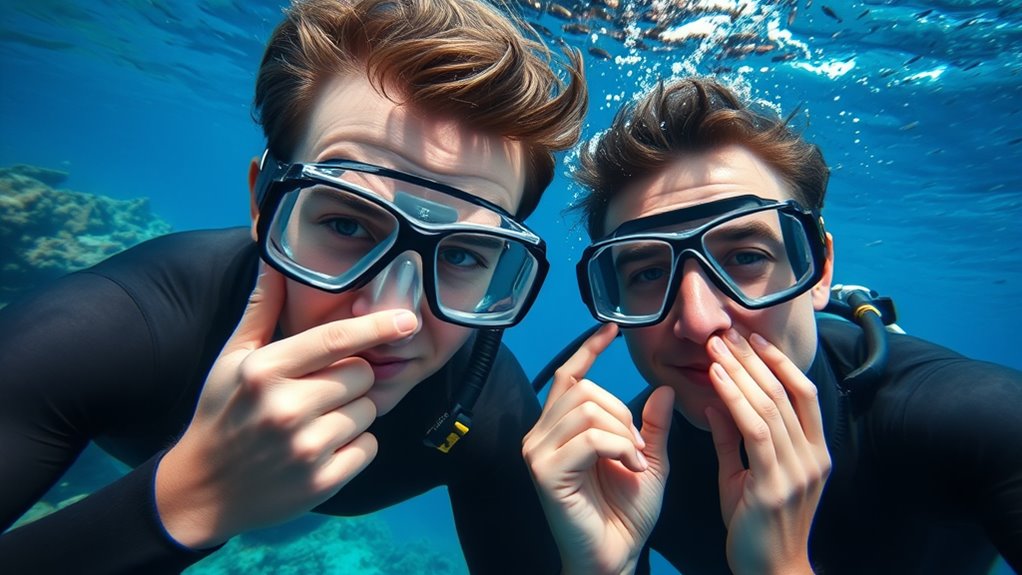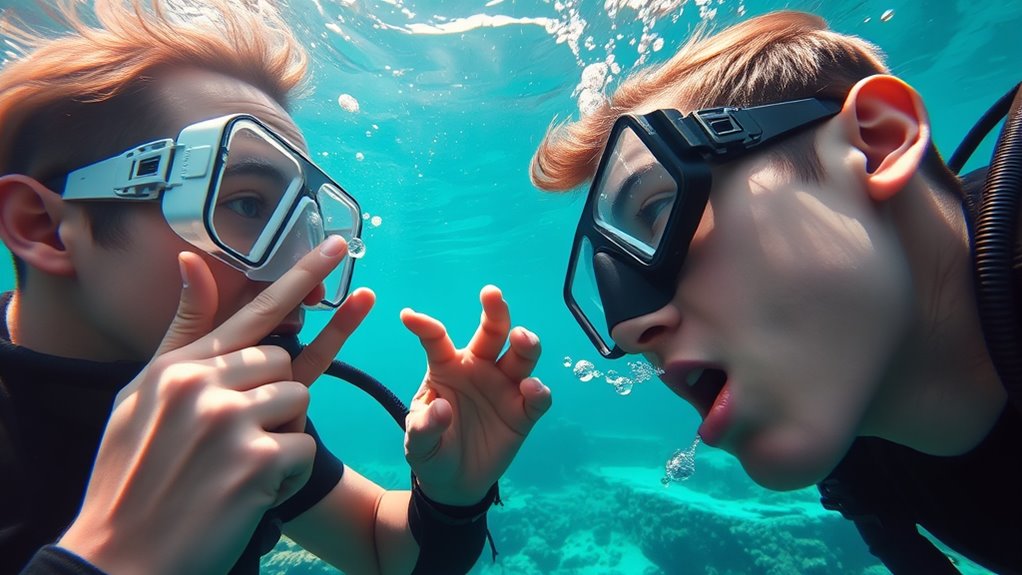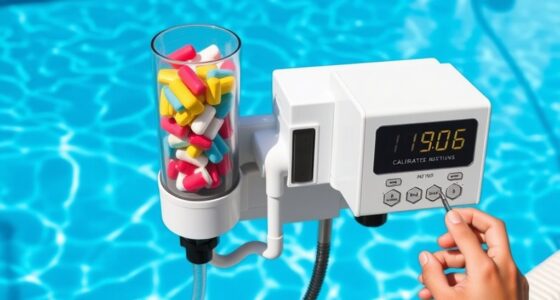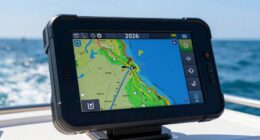When freediving, you can use the Valsalva or Frenzel technique to equalize your ears. The Valsalva involves pinching your nose and blowing gently, which is simple but can cause discomfort if overdone. The Frenzel maneuver uses throat muscles to trap air and is more efficient and comfortable once mastered. To dive deeper safely, understanding both methods helps you choose the best approach—keep exploring to learn more about mastering these techniques.
Key Takeaways
- The Frenzel maneuver uses throat muscles to actively close the airway and push air into the middle ear, offering more control.
- Valsalva involves pinching the nose and gently blowing to force air into the Eustachian tubes quickly.
- Frenzel is generally more efficient and comfortable for deep dives with consistent practice.
- Valsalva is easier to learn initially but may cause discomfort or ear damage if performed improperly.
- Combining techniques and practicing proper timing improves equalization success and diving safety.
Understanding the Mechanics of Equalization

To understand how equalization works during freediving, it’s essential to grasp the basic mechanics involved. When you descend, your body experiences increased pressure, which compresses the air-filled spaces in your ears and sinuses. To prevent discomfort or injury, you need to balance these pressures by matching the air volume inside your head with the surrounding water pressure. This process involves creating a slight increase in pressure within the middle ear or sinuses to match external pressure. The key is to manipulate the Eustachian tubes, which connect your middle ear to the back of your throat, allowing air to flow into the ear. Proper equalization ensures a comfortable descent and helps prevent barotrauma, enabling you to dive deeper safely. Understanding the different techniques, such as Frenzel and Valsalva, can improve your ability to equalize efficiently and safely during your dives. Additionally, mastering these techniques can contribute to spiritual connection with your diving experience, fostering a sense of harmony and confidence beneath the water. Knowing how to properly equalize is also important for environmental considerations, as it encourages responsible diving practices that protect aquatic ecosystems.
How the Frenzel Maneuver Works

The Frenzel maneuver works by using specific muscles to actively close your airway and move air into your middle ear without relying on the Eustachian tubes. You contract your throat muscles—particularly the back of your tongue and the muscles around your larynx—while keeping your nose pinched shut. This creates a sealed space in your throat, trapping air behind your tongue. When you push your tongue upward and inward, you increase pressure in this sealed area, forcing air into your middle ear through the Eustachian tube openings. Unlike the Valsalva, the Frenzel doesn’t require you to exhale or strain, making it more efficient and easier to control. This technique allows for a quick, controlled equalization, especially beneficial during profound immersions. Additionally, mastering the Frenzel can help improve your color accuracy, leading to a clearer and more vibrant visual experience during dives. Developing a proper technique can also reduce the risk of barotrauma and make your dives safer and more enjoyable. Proper practice of the Frenzel also involves understanding muscle coordination, which is essential for effective equalization.
The Valsalva Technique Explained

Have you ever wondered how the Valsalva technique helps you equalize your ears during a thorough exploration? It’s simple: you pinch your nose shut, close your mouth, and gently blow air into your nasal passages. This increases pressure in your middle ear, forcing the eustachian tubes open. As a result, air flows into the ear, equalizing the pressure between your middle ear and the environment. The Valsalva is quick and straightforward, making it a popular choice for many divers. However, it requires some effort and can be uncomfortable if not done carefully. You should avoid blowing too forcefully, as this can cause damage or discomfort. When mastered, this technique allows you to efficiently manage ear pressure during dives. Proper technique is essential to prevent ear injuries and ensure a safe diving experience. Additionally, understanding the pressure changes during descent can help you better time and perform the Valsalva maneuver effectively, especially since autonomic responses can influence your ability to equalize. Recent AI discoveries in understanding human physiology could further enhance training methods for equalization techniques. Incorporating protective strategies can further reduce the risk of injury during equalization.
Comparing Effectiveness and Ease of Use

While Valsalva may be less demanding initially, the Frenzel can become more comfortable and efficient over time. You are trained on data up to October 2023. Incorporating proper breathing techniques can further enhance your ability to equalize effectively and reduce discomfort during dives, especially when utilizing techniques like the Frenzel that rely on precise air pressure control. Developing consistent equalization skills can also minimize the risk of barotrauma and improve overall diving performance.
Tips for Improving Your Equalization Skills

Practicing consistent, controlled equalization techniques can markedly enhance your skills and comfort underwater. Focus on developing a steady rhythm and gentle pressure to prevent discomfort or injury. To improve, try these tips:
- Regularly practice your chosen method out of water to build muscle memory
- Relax your jaw and throat muscles before equalizing to reduce tension
- Equalize early and often to avoid pressure buildup
- Maintain proper head position, slightly tilting upward to ease ear access
- Use visualization techniques to prepare your mind for smooth equalization
- Incorporating tuning techniques from vehicle modifications can help you fine-tune your equalization approach for optimal performance.
- Understanding ear anatomy can help you identify the best methods for comfortable and effective equalization.
Frequently Asked Questions
Can Certain Medical Conditions Affect Equalization Ability?
Certain medical conditions can definitely affect your ability to equalize while freediving. If you have issues like sinus infections, allergies, or ear problems, it might be harder for you to clear your ears safely. Conditions such as Eustachian tube dysfunction or a deviated septum can also hinder equalization. Before diving, it’s smart to consult a healthcare professional if you have any concerns, ensuring you dive safely without risking injury.
Which Technique Is Safer for Beginners?
When choosing a technique for beginners, you should consider safety first. The Valsalva maneuver is generally safer for newcomers because it’s easier to learn and control, reducing the risk of ear injury. While Frenzel can be more efficient once mastered, it requires more practice and technique. Starting with Valsalva helps build confidence and safety, making it the better choice for those new to freediving.
How Do Pressure Changes During Descent Impact Equalization?
Imagine your ears are a fortress under siege—pressure skyrockets during descent, threatening to crush your eardrums. As you descend, the increasing pressure pushes against your eardrum, making equalization essential. If you fail to equalize early and often, pain and injury strike like lightning. Properly managing pressure changes keeps your ears safe and your dive smooth. You must equalize proactively to conquer the depths without damage.
Are There Specific Exercises to Enhance Equalization Skills?
You can improve your equalization skills by practicing specific exercises regularly. Try pinch nose and gently blow against closed nostrils to develop control, or perform gentle swallowing to activate your Eustachian tubes. Incorporate controlled breathing exercises to increase your lung capacity and relaxation. Over time, these exercises help you become more comfortable with pressure changes, making equalization easier during dives. Consistency and patience are key to mastering these techniques.
How Does Mouth and Throat Anatomy Influence Technique Choice?
You should consider how your mouth and throat anatomy affect equalization technique choice. If your throat muscles are flexible and you can easily control your tongue and soft palate, Frenzel might suit you better. Conversely, if you have limited flexibility or difficulty coordinating muscles, Valsalva could be more practical. Understanding your anatomy helps you select the technique that provides the most comfortable and effective equalization during your dives.
Conclusion
Choosing between Frenzel and Valsalva depends on your comfort and experience, but remember, practice makes perfect. As the saying goes, “Rome wasn’t built in a day,” so be patient and persistent with your equalization techniques. With time, you’ll find what works best for you, allowing you to dive deeper and stay longer. Keep refining your skills, and enjoy the serenity of freediving—your journey is just beginning.










